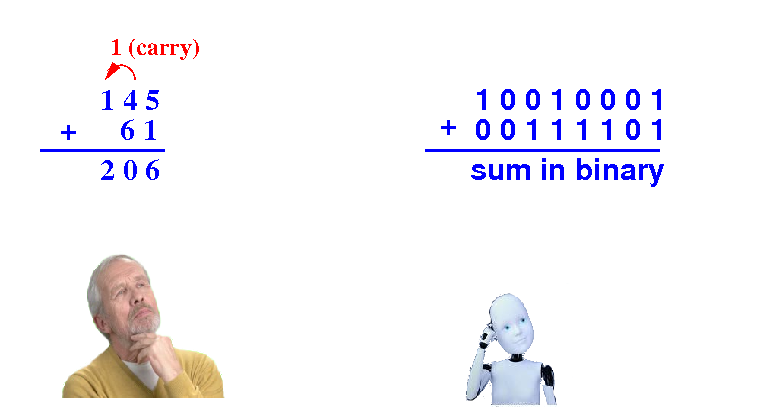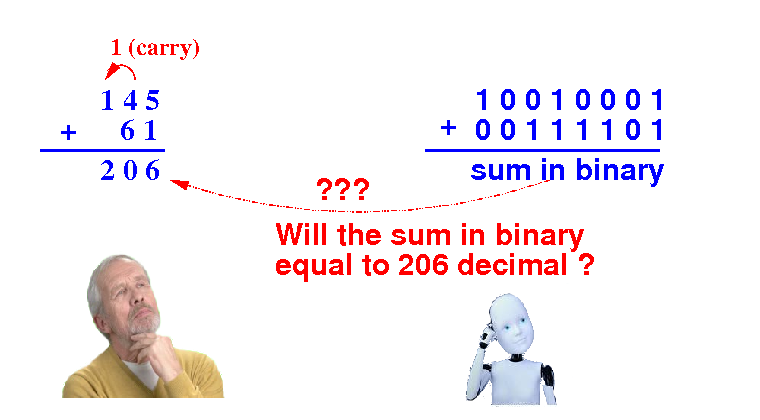Pre-requisite to perform decimal addition
145
+ 61
--------
(You have done this in 3rd grade in elementary school) |
(Partial) Addition table for the decimal number system:
+ | 1 2 3 4 5 6 7 8 9 ---+---+---+---+---+---+---+---+---+---- 1 | 2 | 3 | 4 | 5 | 6 | 7 | 8 | 9 | 10 ---+---+---+---+---+---+---+---+---+---- 2 | 3 | 4 | 5 | 6 | 7 | 8 | 9 |10 | 11 ---+---+---+---+---+---+---+---+---+---- .... etc etc |
Humans will become a "human calculator" after they have learned the (decimal) addition table:

The binary number system also has an addition table:
0 1 0 1
+ 0 + 0 + 1 + 1
--- --- --- ---
0 1 1 10
^
|
+--- carry
|
Adding binary numbers works exactly like adding decimal numbers
The only difference is:
The carry happens when the total (= sum) ≥ 2
Suppose the
computer is
given the
binary representations for
the decimal numbers
145 and
61

The computer performs the addition in binary using circuitry that implements the the binary addition table:

Comment: If you want to know about the computer circuits used to perform calculations, take CS355
$64,000 question: will the sum in binary represent that correct sum value (206) ???

No proofs... I will give some examples to show you that this is a fact
Example:
In decimal In binary
*** * = carry
5 ---> 00000101
+ 7 ---> + 00000111
---- ----------
12 <--- 00001100
|
I will do the addition step-by-step
in class:
00000101
+ 00000111
------------
Example:
In decimal In binary
** * * = carry
145 --> 10010001
+ 61 --> + 00111101
------- ----------
206 <-- 11001110
|
I will do the addition step-by-step
in class:
10010001
+ 00111101
------------
Subtraction table for the binary number system:
0 1 0 1
- 0 - 0 - 1 - 1
--- --- --- ---
0 1 *1 0
^
|
+--- BORROW !
|
Subtracting binary numbers works exactly like subtracting decimal numbers
The only difference is:
When you borrow from you neighbor digit, you will receive 2 units
Example:
In decimal In binary
* * = borrow
9 00001001
- 5 - 00000101
---- ----------
4 00000100
|
I will do the subtraction
step-by-step
in class:
00001001
- 00000101
------------
Example:
In decimal In binary
** * * = borrow
149 10010101
- 41 - 00101001
----- ----------
108 01101100
|
I will do the subtraction
step-by-step
in class:
10010101
- 00101001
------------
Multiplication table for the binary number system:
0 1 0 1
x 0 x 0 x 1 x 1
--- --- --- ---
0 0 0 1
|
Multiplying binary numbers works exactly like multiplying decimal numbers
The only difference is:
Each time the sum reaches 2, you must generate a carry
Example:
93(10) = 1011101(2)
13(10) = 1101(2)
1011101
x 1101
----------
1011101
101110100
1011101000
--------------
10010111001 (= 1209(10))
|
(I will do the multiplication
step-by-step in class):

Decimal division is hard !!!
Example:
0082 (quotient = 82(10))
---------
27 / 2237
0
---
22
0
---
223
216
----
77
54
---
23 (remainder = 23(10))
|
Binary division is extremely easy:
|
Example of a
binary division:

27(10) = 11011(2)
2237(10) = 100010111101(2)
000001010010 (quotient = 82(10))
-------------------
11011/ 100010111101
0
---
10
00
---
100
000
----
1000
0000
-----
10001
00000
------
100010
11011
-------
1111
0000
-------
11111
11011
-------
1001
0000
------
10011
00000
------
100110
11011
-------
10111
00000
------
10111 (remainder = 23(10))
|